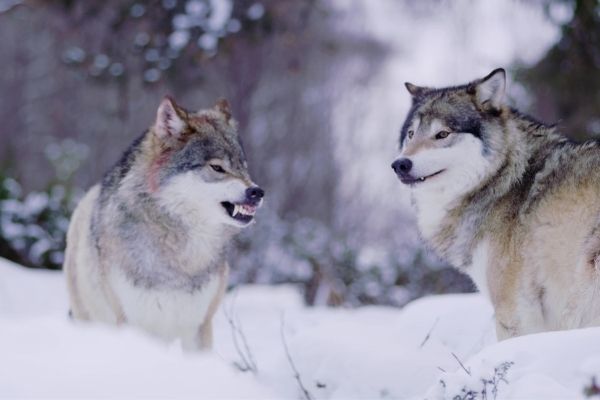The Arctic Wolf is well known as the white wolf that is not afraid of humans. It is an amazing animal with adaptations that enable it to survive in the extreme weather of the Arctic regions. We have gathered a complete set of Arctic Wolf Facts For Kids that will help you in learning All About Arctic Wolves. You are going to learn about its scientific name, classification, appearance, physical description, lifespan, eyes, species, diet, hunting, habitat, range, climate, adaptations, behavior, sense of smell, wolf pack, life cycle, reproduction, baby, endangerment, population, predator, role in the ecosystem and many other interesting and fun facts about Arctic Wolves.
Arctic Wolf Facts For Kids
What Is Arctic Wolf
The Arctic wolf, also known as the polar wolf or white wolf, is a special kind of wolf that lives in the very cold Arctic regions of North America and Greenland. This wolf is not just any wolf; it has some unique features! It’s a bit smaller than some other wolves, has really white fur to blend in with the snow, and its teeth and head are shaped a bit differently to help it survive in its icy home.
Arctic wolves live far away from cities and towns, in places where it’s so cold and remote that hardly any people ever visit. This means they don’t have to worry much about losing their homes or being hunted, which is great news for them!
Scientists have noticed that over time, the heads of Arctic wolves have gotten a bit smaller. They think this might be because they have mixed a little with dogs, but they’re still learning more about why this is happening.
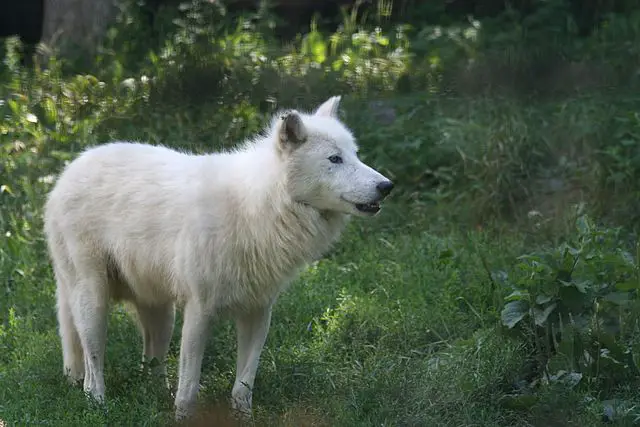
Arctic Wolf Scientific Name
The scientific name of the Arctic wolf is Canis lupus arctos.
Arctic Wolf Classification
The following is the scientific classification or taxonomy of Arctic wolf:
Kingdom Animalia
Phylum Chordata
Sub-phylum Vertebrata
Class Mammalia
Order Carnivora
Family Canidae
Genus Canis
Species Canis lupus
Sub-species Canis lupus arctos
Arctic Wolf Appearance
The Arctic wolf is a medium-sized wolf that can be 3.2 to 5.9 feet, as long as a big sofa, from its nose to the tip of its tail. It has a beautiful white coat that looks just like the snow around it. This wolf is dressed perfectly for the cold with two special layers of fur: one layer is waterproof to keep it dry, and the other is thick and fluffy to keep it warm.
Arctic wolves have a narrow head, a short nose, and tiny ears that help keep them warm in the chilly Arctic weather. They have very strong jaws and 42 sharp teeth that are perfect for eating their favorite food—meat!
These wolves also have short legs and big, soft paws that act like snow boots. This helps them walk easily over the snow and ice without sinking in.
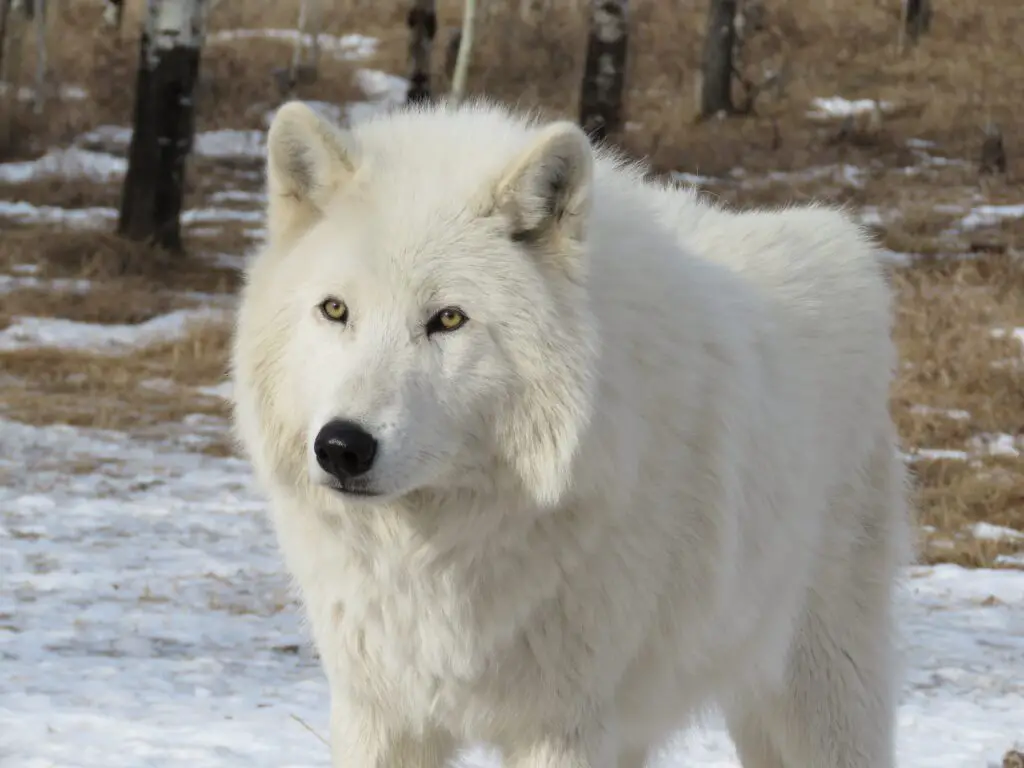
Arctic Wolf Physical Description – Arctic Wolf Characteristics
Arctic Wolf Size
Arctic wolves are medium-sized wolves, and they can be as long as a big dining table, from their noses to the tips of their tails, which is about 3.2 to 5.9 feet! Just like in many animal families, the boy wolves (males) are usually a bit bigger than the girl wolves (females).
Arctic Wolf Weight
These wolves aren’t lightweights either! They can weigh anywhere from about 70 pounds, which is as much as a big dog, up to 175 pounds, which is as heavy as a large refrigerator!
Arctic Wolf Height
When an Arctic wolf stands up, it can be about as tall as a kitchen counter, around 3 feet from its paws to its head. At their shoulders, they’re a bit shorter, measuring between 2 to 2.5 feet tall.
So, imagine a furry white wolf as long as a couch, as heavy as a big dog or a fridge, and as tall as the counter where you help make cookies. That’s an Arctic wolf for you! They’re perfectly built to live and move around in their snowy homes.
Arctic Wolf Lifespan
Arctic wolves have a pretty tough life in the wild, where they usually live about 7 to 10 years. Living in such cold places with not a lot of food around can be really hard! But when they live in places like zoos, where they don’t have to worry about finding food or staying safe from other animals, they can live much longer, even more than 18 years. This is because they get lots of care, regular meals, and help from veterinarians if they get sick. So, just like pets get to live longer because we take care of them, Arctic wolves in captivity get to enjoy longer lives too!
Arctic Wolf Eyes
When Arctic wolf puppies are born, they have pretty blue eyes, just like a clear sky! But as they start to grow up, their eyes change color. By the time they are grown-ups, their eyes usually turn a beautiful shade of golden-brown, kind of like the color of honey or amber. Isn’t it cool how their eyes change as they grow? Just like how some people’s hair gets lighter in the summer sun, Arctic wolves have their own little magic with their changing eye colors!
Arctic Wolf Species
Arctic wolf belongs to the species of grey wolf (Canis lupus).
What Do Arctic Wolves Eat – Arctic Wolf Diet
Arctic wolves are meat-eaters, and they mostly eat other animals. They love to hunt big animals like musk oxen and caribou, but they also snack on smaller ones like Arctic hares, birds, and even beetles. Sometimes, they find food that’s already dead or even rummage through garbage if they need to.
These wolves are really good at working together. They hunt in groups called packs, which helps them catch bigger animals. When there are plenty of musk oxen around, Arctic wolves have more babies because they have lots of food to eat.
Arctic wolves are also smart about finding food. In the winter, they might follow herds of caribou as they move to different places. When they catch something big, they can eat a lot at once—up to 20 pounds of meat! After a big hunt, they guard their food carefully, taking turns to watch out for any animals that might try to sneak a bite.
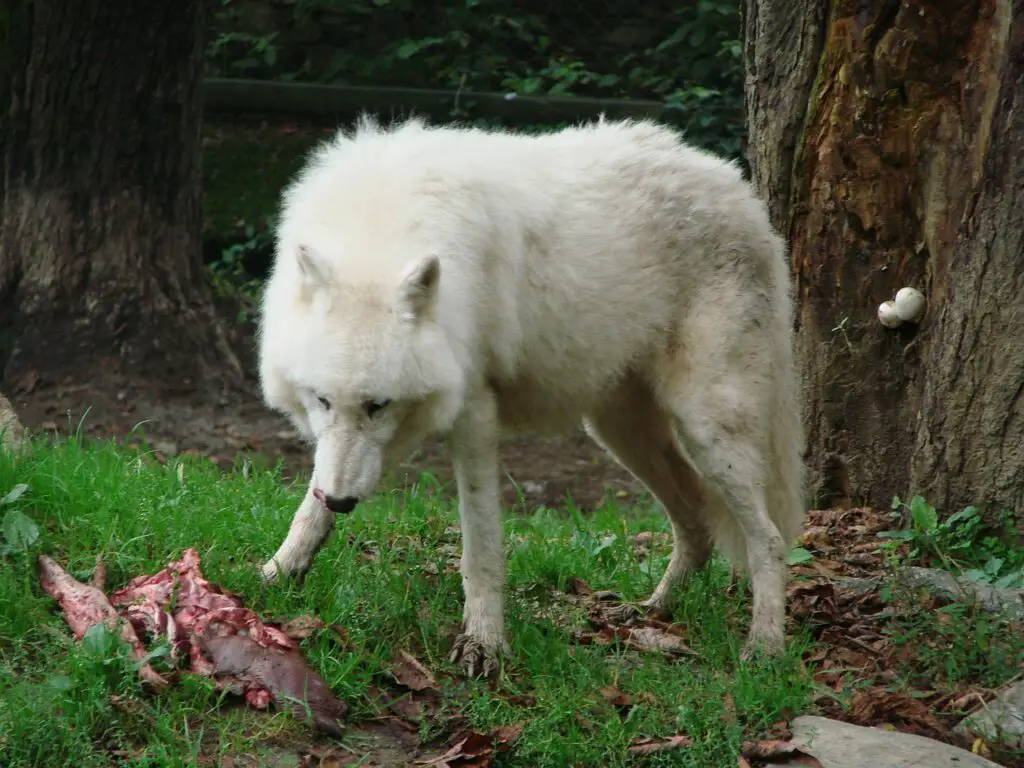
What Do Arctic Wolves Hunt – Arctic Wolf Prey
The most common prey of Arctic wolves are:
- Muskoxen
- Arctic hares
However, they also hunt other animal species like:
- Caribou
- Deer
- Elk
- Moose
- Arctic fox
Lemmings and other rodents
- Seals
- Birds
- Beetles
Where Do Arctic Wolves Live – Arctic Wolf Habitat
Arctic wolves are special wolves that live way up north in the Arctic, where it’s super cold and snowy. This place is called the Arctic tundra, and it’s mostly flat and doesn’t have many trees.
These wolves live in groups called packs, and they need a lot of space to roam and find food. Their home area can be as big as 1,000 square miles—that’s almost as big as a whole city!
Since the ground is frozen all the time, Arctic wolves can’t dig holes to make dens like other wolves. Instead, they find natural shelters like caves or places with big rocks to keep warm and safe.
Some Arctic wolves live close to the ocean. This is really handy because they can eat seabirds and seals, which gives them more food choices, especially when other food might be hard to find in the cold, snowy tundra.
Arctic Wolf Habitat Map
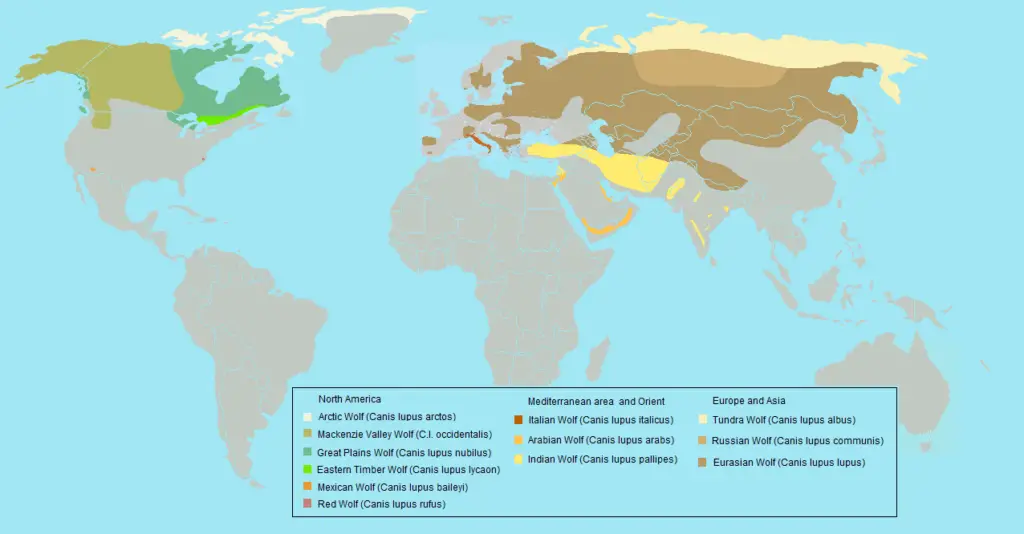
Arctic Wolf Range- Arctic Wolf Location
The habitat range of the Arctic wolves occurs above the latitudes of 67° North.
The location of their habitat is:
- Northern parts of Alaska in the United States
- Queen Elizabeth Islands (from Melville Island to Ellesmere Island) in Northern Canada
- Greenland
Arctic Wolf Climate
Arctic wolves are special wolves that live way up north in the Arctic, where it’s super cold and snowy. This place is called the Arctic tundra, and it’s mostly flat and doesn’t have many trees.
These wolves live in groups called packs, and they need a lot of space to roam and find food. Their home area can be as big as 1,000 square miles—that’s almost as big as a whole city!
Since the ground is frozen all the time, Arctic wolves can’t dig holes to make dens like other wolves. Instead, they find natural shelters like caves or places with big rocks to keep warm and safe.
Some Arctic wolves live close to the ocean. This is really handy because they can eat seabirds and seals, which gives them more food choices, especially when other food might be hard to find in the cold, snowy tundra.
What Other Animals Live With The Arctic Wolf
- The following are some of the other animals that share the Arctic wolf’s habitat:
- Muskoxen
- Arctic hares
- Caribou
- Deer
- Elk
- Moose
- Arctic fox
- Seals
- Many species of birds (such as Arctic tern, snow goose, and ptarmigan)
- Lemmings and various other types of rodents
Arctic Wolf Adaptations
Arctic wolves are amazing animals that live in super cold places like the Arctic. They have some cool tricks to help them survive the freezing weather!
-
Short Snouts and Tiny Ears: Their noses and ears are smaller than other wolves, which helps them stay warm because less heat escapes from their bodies.
-
Camouflage Coats: Arctic wolves have white or light grey fur that helps them blend in with the snow and ice. They wear a double-layered fur coat all year round. The inside layer is super soft and keeps them warm, while the outside layer is tough and waterproof to keep them dry.
-
Snowshoe Paws: Their paws are like built-in snowshoes, covered in fur that keeps them warm and stops them from slipping on ice.
-
Warm Blood System: They have a special setup in their paws that keeps their feet warm even when it’s freezing. The warm blood going down to their paws heats up the cold blood coming back up, so they don’t lose too much heat.
-
Fat Blanket: Under their skin, Arctic wolves have a thick layer of fat. This not only keeps them warm but also gives them extra energy if they can’t find enough food.
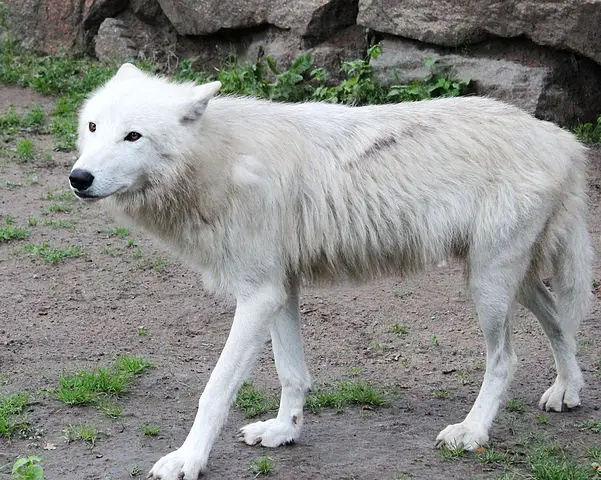
Arctic Wolf Sense Of Smell
Wolves, including Arctic wolves, have an amazing sense of smell! Imagine being able to smell your favorite food cooking from miles away—that’s kind of like how good a wolf’s nose is. Wolves’ noses are way better than ours; they can smell things about 100 times better than humans can!
Inside their noses, wolves have a special area just for smelling, and it’s a lot bigger than the one we have. This helps them pick up scents from far away, which is super important when they need to find food.
Arctic wolves, living in the snowy and icy Arctic, especially rely on their sense of smell to hunt. They can sniff out where animals are hiding, even if they can’t see them. This super sniffing power helps them find and catch their meals in such a tough place to live.
Arctic Wolf Behavior
Arctic wolves are friendly with each other and live together in groups called packs, usually with about five to eight wolves in each one. They need a lot of space to live and hunt, so their home territories are really big—about as big as 1,000 soccer fields put together!
These wolves have special ways to talk to each other. They can use body language, smells, and sounds. One of their favorite ways to communicate is by howling. This isn’t just for fun; it helps them figure out where other wolf packs are and how big they are. If a small pack hears a big pack howling, they might move to a different area to find food so they don’t have to compete with the bigger group.
Arctic wolves are also pretty brave around humans because they hardly ever see people. Sometimes, they might even come up close to check out humans, but they’re always very careful.
In the winter, when it gets super dark all day and night, Arctic wolves might travel to other places where it’s easier to live and find food. It’s hard for scientists to follow them during this time because it’s so dark, so there are still many mysteries about how they move and live during the winter.
Arctic Wolf Pack
Arctic wolves live together in groups called packs. A typical pack has about 5 to 8 wolves, but sometimes there can be as many as 20 wolves together, though that’s pretty rare.
In every pack, there are two leaders called the alpha male and alpha female. They are like the mom and dad of the group, deciding where the pack will go and what they will do.
Most of the time, the pack is like a big family, with the parents (the alphas) and their kids (the pups from different years). They all live together, hunt together, and look out for each other.
When it comes to hunting, the wolves in the pack work as a team to catch big animals that they couldn’t catch alone. This teamwork is really important for their survival.
Everyone in the pack also helps take care of the young wolves, protecting them from dangers and teaching them how to be good wolves as they grow up.
The wolves also have a special way of making sure other packs know where their home is. They leave scent marks around the edges of their territory with their urine. This is like putting up a “No Trespassing” sign to tell other wolves to stay away.
Arctic Wolf Life Cycle
Arctic wolves grow up and can start having families of their own when they are about 2 to 3 years old. When they are old enough, some wolves decide to leave their families to find a partner and make a new home somewhere else. But some choose to stay with their family pack.
In big wolf families, more wolves might have babies. But in smaller families, usually only the mom and dad wolves, called the alpha male and alpha female, have pups.
When two wolves decide to have pups, the mom wolf will be pregnant for about 63 days, which is a little over two months. Then, she usually has 2 to 3 cute little wolf pups.
Arctic wolves in the wild usually live for about 7 to 10 years, but if they live in places like zoos where they are taken care of, they can live much longer, sometimes over 18 years.
Arctic Wolf Reproduction
In a family of Arctic wolves, usually only the mom and dad wolves, called the alpha male and female, have babies. But in really big wolf families, sometimes other wolves can have babies too. Arctic wolves usually stick with one partner.
Their special time to have babies starts in January and goes until March. That’s when the mom and dad wolves decide to start their family. After they mate, the mom wolf will be pregnant for about 63 days, which is a little over two months.
When it’s time for the baby wolves, called pups, to be born, the mom needs a safe place to have them. She might use a natural cave or a rocky area, or she might dig a little hole in the ground if it’s not too frozen. If she can, she’ll even dig a cozy den in the snow.
The little wolf pups are born in late May or early June. They are super cute and stay close to their mom for about two years. During this time, they learn all they need to know about living in the cold Arctic, like how to find food and stay safe.
Female Arctic Wolf
Arctic wolves are interesting animals because the boys (males) are usually bigger than the girls (females). This is something scientists call “sexual dimorphism.”
The mom wolves, or female Arctic wolves, have a very important job. When they have baby wolves, called pups, they feed them with milk and take really good care of them. The mom helps her pups learn everything they need to know about living in the cold Arctic until they are big enough to take care of themselves, which usually takes about two years.
Arctic Wolf Babies – Baby Arctic Wolf – Arctic Wolf Pups
Arctic wolf babies are called pups or whelps. They are born tiny, weighing just 2 to 3 pounds, and they have dark fur. When they first arrive, they can’t see or hear anything, but after about two weeks, they start to see and hear the world around them. Their eyes are blue at first but change to orange or yellow-golden as they get older.
When they’re really little, their mom feeds them milk. As they grow, she begins to bring them soft, chewed-up food to try. They spend their first month and a half in the cozy den where they were born, staying safe with their mom.
After about a month and a half, the pups start to explore outside the den and learn from the rest of their wolf pack. They grow up fast and by 8 months old, they look like adult wolves! They stick with their mom for about 2 years, learning everything they need to know about surviving in the Arctic.
These pups grow up to be part of their pack, usually staying with the same group for many years, and they become mature enough to have pups of their own when they are about 2 to 3 years old.
Are Arctic Wolves Endangered – Why Are Arctic Wolves Endangered
Arctic wolves live way up north in the cold Arctic, and right now, they are not in danger of disappearing, which is great news! They live in such a remote place that they don’t have many of the problems other animals face, like losing their homes or being hunted too much.
However, Arctic wolves do have one big challenge: climate change. This means that the weather in their home is changing in big ways. Sometimes it gets too warm, and other times it can be unpredictably cold or stormy. This makes life tough for the animals they hunt, like muskoxen and Arctic hares. If these animals have trouble finding their own food, then there isn’t as much for the wolves to eat.
So, while Arctic wolves are doing okay for now, we need to keep an eye on how changes in the weather are affecting their icy home and their food. It’s important to take care of our planet to help protect these amazing wolves and many other creatures!
Arctic Wolf Conservation Status
The conservation status of the Arctic wolf on the IUCN Red List as Least Concern.
Arctic Wolf Population
According to the Cool Antarctica Resources, the total population of Arctic wolves is estimated at 200,000 individuals.
Arctic Wolf Role In The Ecosystem
Arctic wolves are very important animals in the wild, much like other types of wolves. They play a huge role in keeping their environment healthy and balanced. Here’s how they do it:
Role in Nature: Arctic wolves help control the number of other animals they hunt, like deer and caribou. This is important because if there are too many of these animals, they might eat too many plants and upset the balance of nature.
Influence on Animal Behavior: The presence of Arctic wolves changes how these prey animals behave. Knowing wolves are around, these animals might choose different places to eat or ways to behave to stay safe. This can help protect certain areas from being overeaten.
Impact on the Environment: Because wolves change where prey animals roam, plants in those areas can grow better. This also allows other smaller animals and different plant species to thrive, which keeps the ecosystem varied and healthy.
Keystone Species: Arctic wolves are known as a “keystone species” because they are crucial for maintaining the structure of their ecosystem. Their impact helps many different plants and animals flourish, shaping the landscape itself.
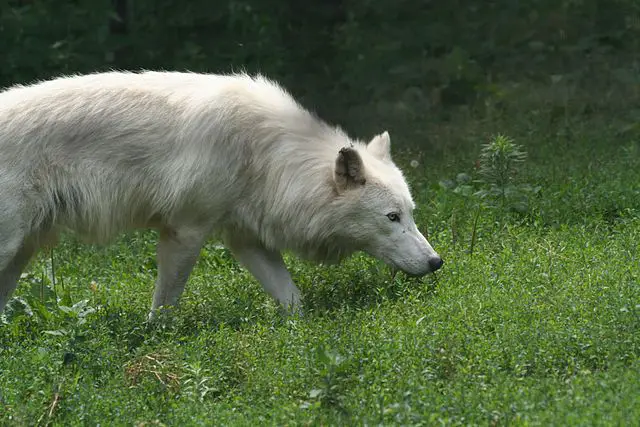
Arctic Wolf Predators
Arctic wolf is itself the apex predator of its habitat. The polar bear is the only natural predator of the Arctic wolf.
Arctic Wolf Interesting Facts – Fun Facts About Arctic Wolves
Arctic wolves are amazing creatures that live far away in isolated areas where few humans ever go. This means they don’t have to deal with problems like cities spreading into their homes or losing their natural spaces. Here’s some cool stuff about Arctic wolves that makes them special:
- Warm Feet on Cold Snow: Arctic wolves have a neat trick to keep their feet warm even when they walk on very cold snow. They have a special system in their feet that keeps the blood warm, so their toes don’t freeze.
- Changing Eye Colors: When Arctic wolf pups are born, they have blue eyes, but as they grow up, their eyes change to brown or golden-brown.
- Super Speedy: These wolves are really fast runners. They can dash up to 40 miles per hour when they’re chasing after animals they want to eat.
- Wolf Pups’ Meals: Baby wolves don’t start with hunting; instead, they eat food that their mom or other wolves in their pack bring back and throw up for them. It sounds gross, but it’s how they get their nutrients!
- Who Can Have Babies: In a wolf pack, only the top wolves, called the Alpha male and female, are the ones who have babies. They lead the pack and make sure everyone is safe and fed.
- Talking Through Howls: Arctic wolves talk to each other by howling. This isn’t just noise; they can tell how big another pack is just by listening to their howls. This helps them understand who’s around them.
- Avoiding Fights: Usually, Arctic wolves try to stay out of trouble with other packs. If there’s a conflict or not enough food, the smaller packs will move to a new area instead of fighting.


